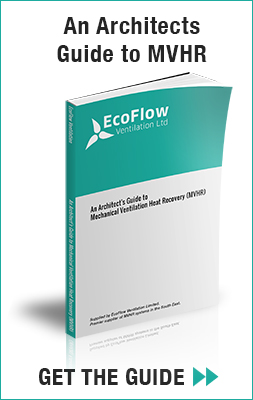You’re planning to build a wholly sustainable home. And you want to achieve the right criteria to meet the requirements of the UK’s Code for Sustainable Homes. Ventilation systems and heating and cooling are part of the package. So how can you make sure the system you choose meets the code and provides the very best levels of home ventilation?
About the Code for Sustainable Homes
The Code for Sustainable Homes was launched by the UK government in 2007. It is designed to replace the old EcoHomes standard, and must be used to inform the design and construction of all new-build homes in England. It’s one of a package of measures that should eventually move the nation further towards its zero carbon development targets. If you want your building to achieve code 3 or 4, it’s more or less a certainty that MVHR needs to be installed. And all social housing funded by government grants must achieve minimum code level 3. So it’s important stuff.
A set of sustainable design principles including health and wellbeing
The guidelines incorporate performance targets across nine core areas, using a simple 1 to 6 star rating system to quantify:
- Energy and carbon dioxide emissions
- Water
- Materials
- Surface water run-off
- Waste
- Pollution
- Health and wellbeing
- Management
- Ecology
The Code rates the entire home as a complete entity. The Code for Sustainable Homes Technical guide sets out the requirements for the Code, and the assessment process, as simply and transparently as possible. The system involves a Design Stage Report and Post Construction Report, which must be provided to the Building Research Establishment, who will hand over a final code certificate assuming all is as it should be.
The health and wellbeing bit – Where new house ventilation takes the stage
Innovative whole house ventilation systems like MVHR are a key part of the whole, delivering significant occupier benefits as regards health and wellbeing.
There’s plenty of scientific research proving the health and mental benefits of simple fresh air. For example it appears that Victorian hospitals, with their big open-able windows and high ceilings, are healthier for patients than modern hospitals with their super-efficient insulation and lack of opening windows.
Mechanical Ventilation Heat Recovery technology delivers huge amounts of clean, fresh air to the home, which has significant health benefits to those who live there. In fact, continuous mechanical ventilation systems are a primary feature of the UK government’s 2010 Domestic Ventilation Compliance Guide.
Contemporary home ventilation systems – Energy and CO2 emissions
MVHR system compliance
MVHR home ventilation systems also cover the energy use and CO2 emission aspects of the Code, both positively impacted by MVHR systems: because MVHR cuts energy use dramatically when heating or cooling a home, there are correspondingly fewer CO2 emissions.
Useful domestic ventilation and sustainable homes guides
- If you’d like to study the Code for Sustainable homes, here it is on the Government’s planning portal.
- Click on this link to explore the Government’s Domestic Ventilation Compliance Guide. The guide gives detailed guidance to help you arrange installation, testing and commissioning of fixed ventilation systems like MVHR.
- Any questions about MVHR? Contact us – we’ll be pleased to help, no strings attached.





Leave A Comment